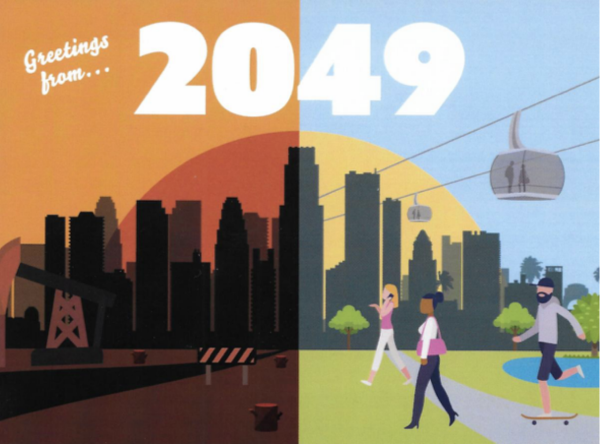In Case You Missed It: This month’s ICYMI is adapted by a piece written by Andy Goodman in January 2020. In it, Andy chats with Climate Resolve and asks the question: when it comes to action around climate change, is fear or hope a more effective tool?
The question inspiring this month’s newsletter is one I hear with regularity during our workshops and webinars. My response, which I stand by even though it sounds like a dodge, is: “It depends.” Just a few weeks ago, however, I was compelled to rethink that answer when I received an end-of-year solicitation from Climate Resolve, a Los Angeles-based nonprofit.
 Climate Resolve works to put a local face on climate change, and they are small but effective. They convinced the city of LA to update its building code so that all new or refurbished buildings will include “cool roofs,” and in 2019 they killed plans for a new 8-12 lane freeway that would have created even more sprawl in a region that already defines the term.
Climate Resolve works to put a local face on climate change, and they are small but effective. They convinced the city of LA to update its building code so that all new or refurbished buildings will include “cool roofs,” and in 2019 they killed plans for a new 8-12 lane freeway that would have created even more sprawl in a region that already defines the term.
Jonathan Parfrey founded Climate Resolve in 2010 and serves as its Executive Director. Parfrey knows his way around the nonprofit world in general and the environmental community in particular. He served as the LA Director of Physicians for Social Responsibility for 13 years, as a commissioner at the Los Angeles Department of Water and Power for 5 years, and he cofounded the statewide Alliance of Regional Collaboratives for Climate Adaptation. When Jonathan and his team try something new, it gets my attention, so I called him last week to find out why they decided to use both fear and hope in their solicitation, and more importantly, if it worked.
From the outside, the letter from Climate Resolve that arrived in early December looked more like a holiday card than anything else, right down to the stamp. This was entirely intentional. The solicitation targeted 5,000 likely donors, mostly in Southern California, and the primary target was millennials. Parfrey told me that using direct mail was influenced by an article he read in Forbes that said millennials pay more attention to snail mail because they get so little of it.
The card inside was designed by Ride or Cry, a marketing firm that works mostly on rock concerts. Parfrey thought they would be an ideal partner for this project because “the aesthetic we get working with them is tilted towards a younger audience,” he said. Here is the cover they designed for the card:

When I opened the card, which has the look and feel of a standard greeting card, rather than seeing a blank area on top and a message on the bottom, I saw two messages of equal length filling the interior. The message on the top panel of the card, dated “December 31, 2049,” read as follows:
Dear Andy,
It’s another blisteringly hot day – our second killer heat wave this December.
And we thought our summers of 30 years ago were hot. Little did we know.
Some days, it’s 100% dangerous to go outside. And indoors, too, our house doesn’t stay cool for long, due to the rolling blackouts. Most days the AC is useless.
I dream about how it used to be… we simply did not act in time. We saw sea levels slowly rise, wildfires burn more frequently, and droughts last longer. We saw the decline before our eyes and still, we just didn’t understand the gravity of it all.
Back in 2020, our leaders failed us – perhaps better put, we failed to sufficiently push our leaders. We had the solutions. We had the technology. Why did we passively accept this miserable future? I wish we’d pushed harder to make a difference.
Anyway, best wishes for the new year…
Your Loving Grandchild
The message on the bottom panel of the card, which had the same date and was also sent to me (by name) from my “loving grandchild,” said this:
Getting ready for next year’s Olympics in Los Angeles. (Our fourth time! I know it’s a little embarrassing.)
The days are warm here in LA but we’ve taken quite a bite out of the heat as a result of our cool city program. Cool pavement. Shade trees. Cool walls. Cool roofs. Green spaces – all together we’ve lowered temperatures significantly. LA isn’t the post-apocalyptic city that “Blade Runner” predicted. In just a few short years, we were able to transform this jumble of dark asphalt and tree-impoverished neighborhoods into a thriving healthy network of livable communities.
I’m thankful for you. You worked to make cooling solutions possible. You saw the signals of climate change and saw it as a challenge that we could overcome. You listened to the wisdom of scientists and indigenous people in the right ways to handle wildfire, drought, and heat waves – all the things that used to plague us. You helped Los Angeles become a beacon for cities across the world.
Thank you. And hey – happy new year.
So there it was: a shot of fear with a chaser of hope. The idea for presenting alternative visions for Los Angeles was one that Climate Resolve had been kicking around for several years. “We thought presenting these two alternative LAs would make a great comic book. Or what if James Cameron used his CGI skills to show two different versions of our fair city? It’d be powerful,” said Parfrey.
When the organization decided to do a year-end solicitation – the first in its ten-year history – Parfrey was convinced that themoment had finally arrived to give the dual-vision concept a try. Michael Parada, Climate Resolve’s manager of communications, wrote the first draft of the text and Parfrey provided the final polish.
“Our people are unaccustomed to getting solicitations from us,” said Parfrey, “so this was part of a larger effort. Getting money was only part of the goal. The other part was communicating that we’re smart, we’re creative, we can be trusted, and we’re going to ask for money.” That said, the piece did pretty well, raising somewhere between $15,000 and $20,000 on an investment of $5,000.
And as to the central question of using both fear and hope: “I think we’re in a moment where fear is a stronger motivator than hope,” Parfrey began. “I’m looking at the evidence. I’m looking at Greta Thunberg. There is a tinge of the apocalypse in her framing.” But Parfrey was quick to add that fear, by itself, isn’t the only button to press.
“The data is clear on this,” he said. “The more dire the messages sound, the more individuals will tuneout. And I say this with full-knowledge that the climate picture is dire. You have to be honest, you have to present the sobering information, yet we still have the choice before us to dramatically improve the situation or make it worse. The choice is still ours.”
Before our conversation was over, Parfrey qualified his comments, saying that this analysis pertains only to messaging around climate change, and that it is not necessarily appropriate for all causes. So noted. But as you, dear reader, prepare for a new year, ask yourself this: If your organization has been wielding the carrot or stick exclusively, has the time arrived to try both?
To learn more effective ways to communicate your organization’s message, register for our “Strategic Communications: Cutting Through the Clutter” Workshop on July 8 & 10.